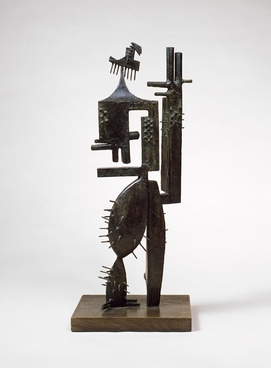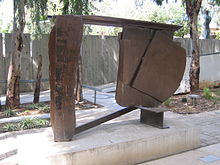Juli González i Pellicer (21 September 1876 - 27 March 1942) was a Spanish sculptor and painter who developed the expressive use of iron as a medium for modern sculpture.
Biography

Born in Barcelona, as a young man he worked with his older brother, Joan, in his father's metal smith workshop. Both brothers took evening art lessons at Barcelona's Cercle ArtÃstic de Sant Lluc, and in the late 1890s Julio introduced himself into Barcelona's artistic life, visiting Els Quatre Gats, a café which was the meeting point of many artists, especially those related with modernisme. There he first met Pablo Picasso. After his father's death in 1896 and closing the family jewelry workshop, both brothers settled in Paris in 1900 after several temporary visits, but still traveled periodically to Barcelona for work reasons.
Paris
In Paris he associated with the Spanish circle of artists of Montmartre, including Pablo Gargallo, Juan Gris and Max Jacob. In 1918, he developed an interest in the artistic possibilities of welding, after learning the technique whilst working in the Renault factory at Boulogne-Billancourt. This technique would subsequently become his principal contribution to sculpture, though during this period he also painted and â€"especiallyâ€" created jewellery pieces. In 1920 he renewed his acquaintance with Picasso, for whom he later provided technical assistance in executing sculptures in iron, participating to Picasso's researches on analytic cubism. He also forged the infrastructures of Constantin BrâncuÈ™i's plasters. In the winter of 1927-28, he showed Picasso how to use oxy-fuel welding and cutting. From October 1928 till 1932, both men worked togetherâ€"and in 1932, González was the only artist with whom Picasso shared his own personal art carnet. Influenced by Picasso, the fifty-year-old González deeply changed his style, exchanging bronze for iron, and volumes for lines.
In 1937 he contributed to the Spanish Pavilion at the World Fair in Paris (La Montserrat, standing near Guernica), and to Cubism and Abstract Art at the Museum of Modern Art in New York. That same year he moved to Arcueil, near Paris, where he died in 1942.
Public collections

The Art Institute of Chicago, the Cleveland Museum of Art, the Hirshhorn Museum and Sculpture Garden (Washington D.C.), the Honolulu Museum of Art, the Kröller-Müller Museum (Otterlo, Netherlands), the Los Angeles County Museum of Art, the LuÃs Ãngel Arango Library (Bogotá, Colombia), the Mary and Leigh Block Museum of Art (Northwestern University, Evanston, Illinois), Musée des Beaux-Arts de Rennes (France), Museo Nacional Centro de Arte Reina SofÃa (Madrid) Museo Patio Herreriano de Valladolid (Spain), Museu Nacional d'Art de Catalunya (Barcelona, Spain), the Museum of Modern Art (New York City), the Nasher Sculpture Center (Dallas, Texas), the National Gallery of Scotland (Edinburgh), the Peggy Guggenheim Collection (Venice), the Philadelphia Museum of Art, the Pompidou Center (Paris), the Solomon R. Guggenheim Museum (New York City), and the Tate Gallery (London) are among the public collections holding work by Julio González. The biggest collection of this artist's work is held by the IVAM (Valencia’s Institute of Modern Art), in the city of Valencia, Spain, with close to 400 pieces.
Artworks
- Still life II, conserved at MNAC
References

Further reading
- Nancy Marmer, "Julio Gonzalez: Sculpture in Iron," Art in America, November/December 1978, pp. 23â€"24.
External links

- Guggenheim Museum biography
- The Legacy Project, Visual Arts Library
- Spanish Painters, biographies
- IVAM (Valencia’s Institute of Modern Art)

